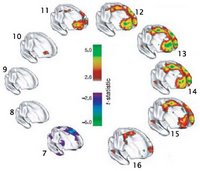The Structural Signature of Intelligence
 A fascinating series of articles in today's issue of Nature documents work by NIMH researchers using MRI imaging to track structural changes in cortical thickness. Although one cannot predict IQ in adults or childen on the basis of cortical mass or thickness alone, the developmental trajectory of thickness changes are significantly related to IQ, such that those with the highest IQs (121-145) show an initial reliatively thin cortex, which rapidly thickens, and then thins again by 11 or 12 years of age.
A fascinating series of articles in today's issue of Nature documents work by NIMH researchers using MRI imaging to track structural changes in cortical thickness. Although one cannot predict IQ in adults or childen on the basis of cortical mass or thickness alone, the developmental trajectory of thickness changes are significantly related to IQ, such that those with the highest IQs (121-145) show an initial reliatively thin cortex, which rapidly thickens, and then thins again by 11 or 12 years of age."Brainy children are not cleverer solely by virtue of having more or less gray matter at any one age. Rather, IQ is related to the dynamics of cortex maturation,” said Rappoport, one of the authors on the study. A similar sentiment was expressed by Shaw, the lead author: "The story of intelligence is in the trajectory of brain development.” This relationship was strongest for prefrontal cortex thickness, which is often thought to be the seat of planning, strategizing, and other "executive functions." Although many previous studies attempting to relate IQ to brain structure were cross-sectional, this longitudinal study better controls for individual variation by following the same 307 subjects betweeen the ages of 5 and 19. They estimated IQ with subscales of the WAIS IQ test.
As Steven Rose points out (whose recent book was quite good), the IQ approach taken by these authors does not allow for direct causal ties between specific cognitive abilities and neural structure. Everything from emotional skills to recall ability may have some role in these net measures of IQ used here, and therefore it's difficult to tie this structural data to a cognitive level. More specific cognitive measures would have been helpful for interpreting the results of a a study this size.
A similar problem is that this research does not bear on the underlying mechanisms that give rise to this relationship between structure and IQ; it is purely descriptive. One parsimonious possibility, which is certainly supported by data, is simply that the smartest people are those with the most plasticity: indeed, those with superior intelligence show the most rapid thinning and the most rapid thickening of the cortex. As it turns out, IQ is significantly related to the speed of stroke recovery, which provides converging evidence for this hypothesis.
A second, related possibility is that the thickening stage is driven by myelination, a developmental process involving the encasement of neurons in white tissue which increases electrical conductance. Experience dependent pruning may also be involved in the cortical thinning trends observed.
Although it is tempting to attribute these complex developmental trends directly to genetic influences, this conclusion is premature and is even likely to be inaccurate. The relationship between gene expression and IQ is heavily modulated both by complex patterns of protein expression and interactions with the environment. For example, cortical thickness in rats is affected by the relative richness of their environment; in macaques, hippocampal neurogenesis only occurs in the absence of stress; likewise, as commentator Richard Passingham points out, changes in human cortical thickness could even be a result of practice. Or, it could simply be that more intelligent children are more likely to live in enriched environments.
Perhaps the strangest feature of this data is that IQ and cortical thickness have an initially negative relationship in the smartest subjects, which turns into a positive relationship as childhood progresses. A series of beautiful images in nature documents this reversal, one of which is included at the start of this article, shows the correlation between thickness change and IQ at each age.


0 Comments:
Post a Comment
<< Home